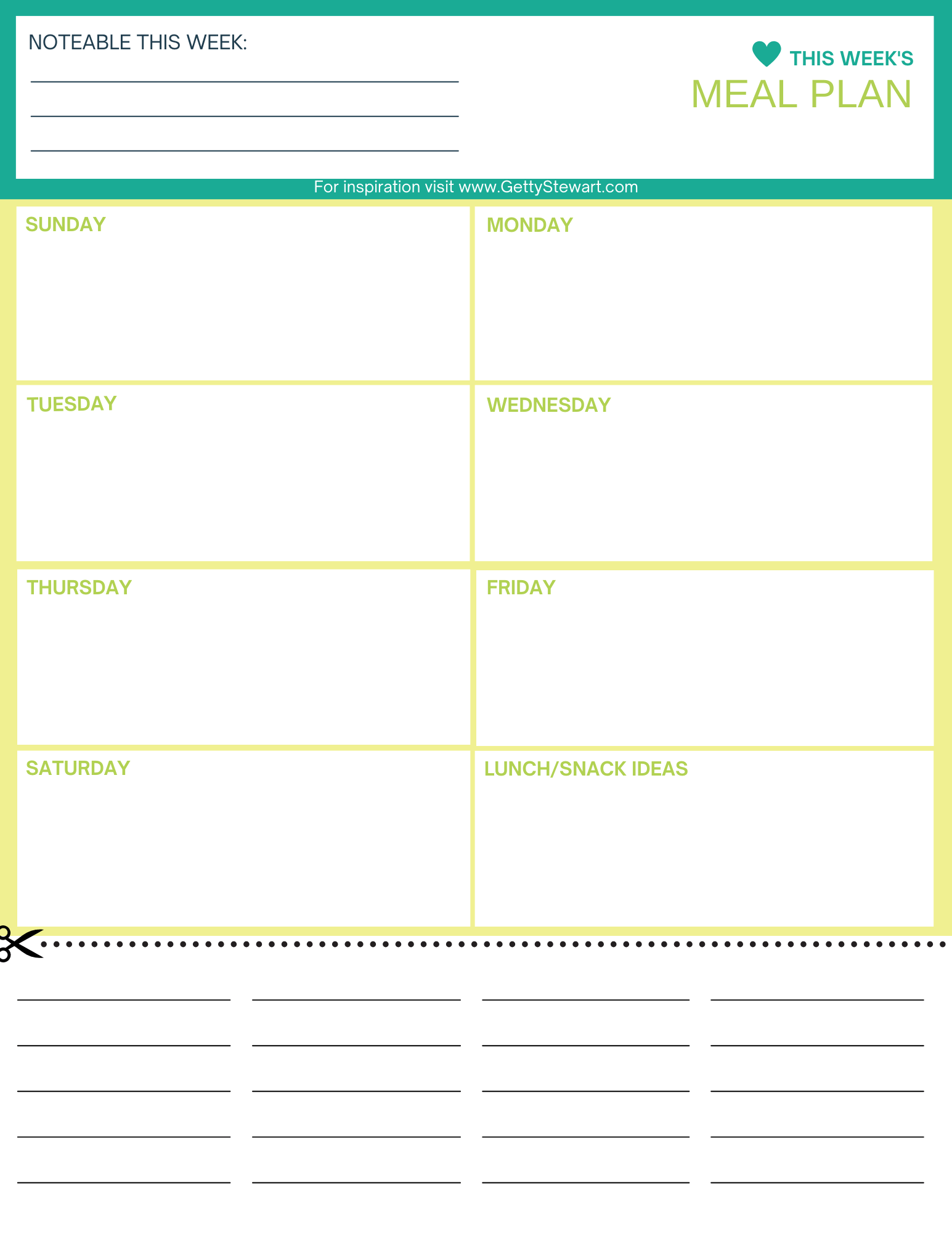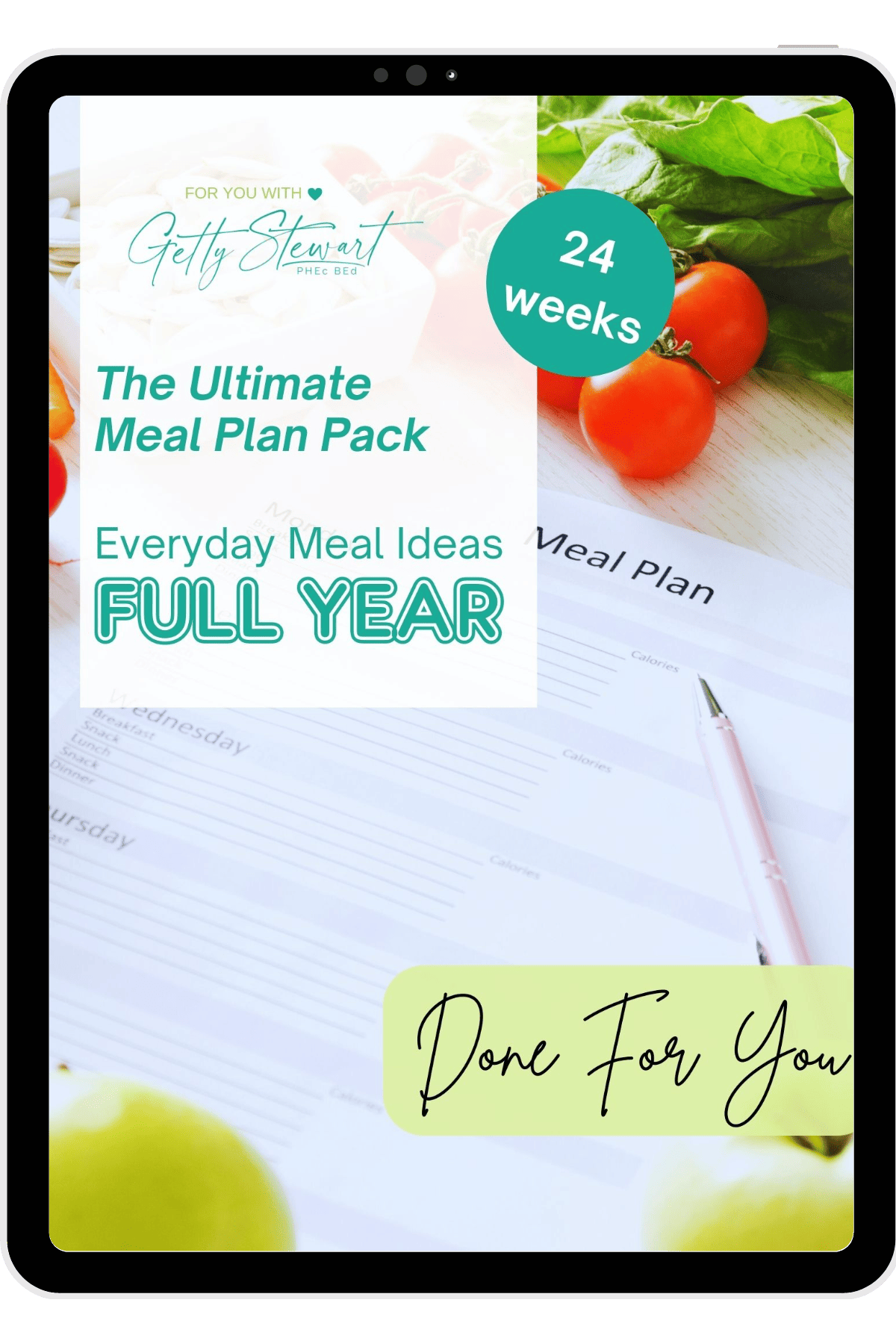How to Meal Plan to Save Money and Eat Healthy
Creating a weekly meal plan is good habit to adopt. It doesn’t have to be a long, complicated process. Just jotting down a few ideas for what to eat during the week ahead can go a long way towards helping you save money, eat healthier, reduce food waste and lower the daily stress of figuring out “What’s for Dinner”.
Start with a Weekly Meal Planner
Read more: Why Seasonal Food Matters, Grocery Shopping Tips to Save Money, 5 More Ways to Save Money.
I don’t plan my meals every week – but when I know there’s a particularly busy week coming up, that’s when I’ll jot down meal ideas and shop accordingly. It truly makes meal prep and the mental mind game that goes with cooking for a family soooo much less stressful. A few years ago, I created this weekly meal planner with a built in shopping list to make planning even easier. You can download it for FREE here.
The bonus of a meal planner like this versus random scraps of paper is that I actually keep each meal plan and can use it another time. I have a folder full of menus for future inspiration (and to help me remember what we liked)!

If you want to see one that’s filled out and great for winter foods, check out this sample.

Get Your Weekly Meal Planner
Tips to Create a Meal Plan
Here are some tips and strategies that I have found helpful when making meal plans.
1. Make Time to Plan
Carve out a time to make your weekly meal plan and grocery list. Because the meal planning leads to the grocery list, it makes sense to do this a day or two before you go shopping. I typically do my planning on the weekends, often while Sunday dinner is already being thawed or on it’s way. It’s a boost of confidence to jump right in knowing that the first slot is done. And, because Sunday dinners usually produce a lot of leftovers, Monday’s meal is often easy to fill in too! Chicken dinner Sunday, turns into Chicken Corn Chowder on Monday.
2.Take Inventory
Consider what’s in your fridge, freezer, pantry or garden. After you’ve slotted a few ideas based on what you already have, check local flyers for what’s on sale that can complement or add to what you already have.
3. Check Everyone’s Calendar
Identify hectic nights when everyone has to be somewhere else and sit-down meals are impossible. These days require foods that you or your family members can quickly reheat and eat on the road or at the kitchen counter. Consider freezer meals, soups, stews, prepared salads and wraps for these days. At our house soup, scrambled eggs or grilled cheese sandwiches with a handful of raw veggies are our go to meals on days like these.
4. Choose Seasonal Foods
Fresh, seasonal foods are tastier and more affordable. And, by eating what’s in season you’ll get plenty of variety in your meal plans. For example, did you know that January to March is citrus season; a good time to add oranges and grapefruits to your meal plans.
5. Plan with Healthy Eating in Mind
If healthy eating is important to you, plan for it. Think about how you can include the following:
- Eat More Fruits and Vegetables of All Colours
- Eat More Whole Grains and High Fibre Foods
- Choose a Variety of Lean Protein Sources
- Reduce Sugar, Salt & Overly Processed Foods
- Choose and Use Fats Wisely
6. Focus on “TnT” Recipes
Be realistic and rely on tried and true (TnT) recipes that you know your family loves and that are easy to prepare. Sure, it’s fun to look for and try new recipes, but don’t cram your week with new recipes that require extra time and ingredients you’re not familiar with. Try a new recipe now and then, but don’t overburden yourself.
7. Involve Your Family
Get the whole family to suggest meal ideas and to help with meal prep. If a particular meal is too tricky for young helpers, get them peeling carrots or grating cheese for a meal coming up later in the week. If nothing else, they can help set the table. If your kids are older, assign a night when they plan and make supper.
8. Consider Theme Nights
Use theme nights to help you come up with ideas for what to include in your meal plan. Here are some ideas we’ve used:
- Meatless Monday – think beans, tofu, tempeh, eggs, etc
- Try it Tuesday – try a new recipe or a new food item
- Kid Friendly Wednesday – meals I know the kids will love (spaghetti, tortillas, hamburgers, homemade mac & cheese, etc.)
- Quick & Easy Thursday – a take a meal from the freezer, breakfast for dinner, sandwiches, grilled cheese
- Pizza Friday – homemade or take out – depends on the week!
- Free for All Saturday – the day when everyone feeds themselves
- Big Dinner Sunday – a traditional Sunday dinner with enough for left overs
9. Plan to Cook Once and Eat Twice
Think about which meals can be easily doubled to freeze for another week or which ones will make great leftovers for lunches or a second dinner. Since you’ve got all the ingredients and cooking utensils out already, this approach will save time and the number of dishes to be cleaned. For example, most soups, stews and casseroles can be easily doubled and frozen and extra mashed potatoes one day can be turned into shepherd’s pie or fried patties the following day. See What to Freeze and What Not to Freeze.
10. Keep & Reuse Your Meal Plans
Hold on to your meal plans so you can reuse them or at least reference them for inspiration in future weeks. If possible, jot a few notes on what worked, what didn’t work, which recipe you used and anything else noteworthy.
Get Your Weekly Meal Planner
Do you make meal plans? What’s your favourite tip? I’d love to hear your thoughts, please leave a comment.
Sign up to get articles by Getty delivered to your inbox. You’ll get recipes, practical tips and great food information like this. Getty is a Professional Home Economist, speaker and writer putting good food on tables and agendas. She is the author of Manitoba’s best-selling Prairie Fruit Cookbook, Founder of Fruit Share, a mom and veggie gardener.





Hey Getty
Yes, I’ve been meal planning for about a year or so. Not for me, actually, but for Trevor. He cooks Monday to Thursday, and what he always hated the most was meal planning and grocery list on sundays. And I always had to help, which wasn’t really fun for me, either. So I sat down one day and just did it once. I made an index card for each of ten weeks and listed 4 meals on each card. I had previously made other index cards with, not the full recipes, but the list of ingredients for each recipe (not staples like salt & pepper, but stuff that would need to be purchased) and where to find the recipe (which book and page number). The cards are organized by main ingredient or type (beef, chicken, vegetarian main dish, side dish, etc.). So now on Monday mornings, Trev can look at his card for the week, pull out his relevant ingredient cards, and quickly make his own shopping list (so I don’t have to make the shopping list anymore – yay!). Friday- Sunday and vacations I cook, and I save those nights for the spontaneity that I love. We’ve tweaked the rotation a bit, and sometimes he goes “off-script”, but he loves the system. I was worried it might not be enough variety for me (spaghetti & meat sauce again? It’s only been 10 weeks!), but actually it’s better because he used to have his go to meals that we’d have a little more often. Plus there’s my vacation days in there or events where we eat out, etc. that stretch the 10 weeks out. Win-win!
Thanks for sharing your meal planning technique Leanne! A little work up front seems to have paid off big time for you and your family – you get your favorite homecooked meals and never have to make a shopping list again! The power of meal planning.